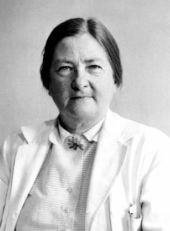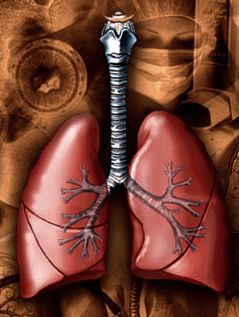Overview
History
Although there were reports of infants who appeared to have cystic fibrosis as early as the 17th century, it wasn't recognised as a specific condition until the 1930's.
The first clear description of the disease was provided by Dr Dorothy Andersen in 1938. She showed that what is now called CF was different from celiac disease in that in CF there was a progressive lung destruction leading to death in infancy or early childhood. Andersen also gave the disease its name, calling it 'cystic fibrosis of the pancreas' . This was due to the fact that the deceased patients she examined had cysts (fluid filled sacks) and scar tissue (fibrosis) which replaced the majority of the normal tissue in the pancreas.
By 1946, some of the genetics associated with cystic fibrosis were discovered by analysing patients with the disease. Through investigation into the disease inheritance pattern in famiies, researchers concluded that CF was a recessively inherited condition caused by a mutation in one gene.
In the 1950's and 60's, many children born with CF were misdiagnosed with pneumonia and chronic bronchitis. This was due to the lack of information available about the disease, and children born in this time period often died of malnutrition. Children born with CF in the 1960s had a life expectancy of approximately four years.
By the 1970s patients of CF were living alot longer and could live to be young adults. This was due to research into the disease which lead to wider medical awareness, earlier diagnosis and improved treatment methods. Doctors also advised patients to eat a high fat, high calorie diet and take digestive enzymes to help the body to absorb nutrients required. Sufferers of CF in the 1970s were therefore healthier and had an increased life expectancy.
In the 1980s survival of CF sufferers continued to improve, but new challenges were faced as patients of the disease got older. Problems such as liver damage and build up of potentially deadly bacteria occurred which were unheard of in younger patients. Despite this, sufferers began to live until their thirties. The CF gene mutatution was identified in 1989 as CFTR.
Current life expectancy for CF patients hasn't increased much since the 1980s, and now stands at 31. However, continous research is being conducted into the condition including development of new treatments which will hopefully in the future allow patients to live to old age.
Photo of Dorothy Andersen. Image courtesy of https://commons.wikimedia.org/wiki/File:Dorothy_Hansine_Andersen.jpg Image is in the public domain and therefore free of any copyright restrictions
Processes underlying the disease
Cystic fibrosis is an inherited condition caused by a gene mutation which is passed down through families. The mutation lies in a gene coding for the cystic fibrosis transmembrane conductance regulator (CFTR) channel, which is important for the movement on chloride ions and also affects other ion channels of the body. This mutation has massive effects on the normal functioning of the body, including respiration, digestion and reproduction.
 There are many different mutations which can be present in the CFTR gene to cause cystic fibrosis, and there are still more to be identified. However, the majority of people with this condition have the same mutation.
There are many different mutations which can be present in the CFTR gene to cause cystic fibrosis, and there are still more to be identified. However, the majority of people with this condition have the same mutation.
Cystic Fibrosis is a serious condition which is always fatal. However, continuous research is being conducted to identify a cure for the condition, which will hopefully allow patients in the future to live long, healthy lives.
Living with Cystic Fibrosis
Cystic fibrosis can have a huge impact on the lives of sufferers, and also on their friends and family. It is a condition which requires life-long treatment, and due to persistent chest infections, involves alot of hospital visits. Diagnosis can be very stressful for families.
One of the biggest challenges faced for families of cystic fibrosis patients is the organisation required on a day-to-day basis to treat them. Physiotherapy needs to be conducted twice a day, along with taking various medication and sticking to a strict diet. Due to the fact that the condition is present from birth, it is sometimes difficult to make children comply with the strict routine required as they don't understand their condition.
Employment
As CF patients are now living longer, healthier and more independent lives alot of patients take on the opportunity to go to work, either part-time of full-time.
However, employers would need to be flexible about factors such as sick leave, hospital appointments etc. For this reason there is some prejudice when people with CF look for employment.
Fertility
Although people with cystic fibrosis can usually lead a normal sex life, the condition can often affect their fertility.
 Men are almost always infertile as there is an abnormality in the vas deferens of the reproductive tract. However, sperm is produced so techniques can be used to extract sperm from the epididymus and use it for in vitro fertilisation. This has a success rate of approximately 20-30%
Men are almost always infertile as there is an abnormality in the vas deferens of the reproductive tract. However, sperm is produced so techniques can be used to extract sperm from the epididymus and use it for in vitro fertilisation. This has a success rate of approximately 20-30%
Women's fertility can also be affected due to thicker cervical mucus. This makes conception more difficult as sperm find it difficult to move through this mucus. However, conception is not impossible and there have been successful pregnancies in CF women.
Images of lungs https://www.flickr.com/photos/huesofheather/385497373/, baby https://www.flickr.com/photos/leeweemeng/2527661422/ and fertilisation https://www.flickr.com/photos/16921864@N04/2417838627/ courtesy of Flickr under the creative commons licence
